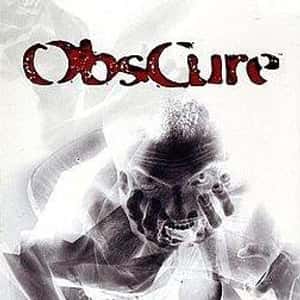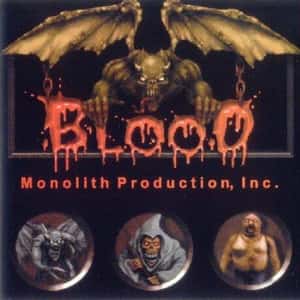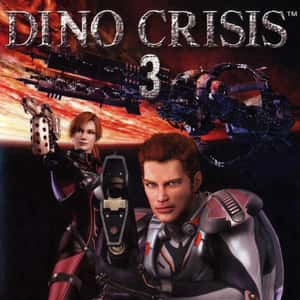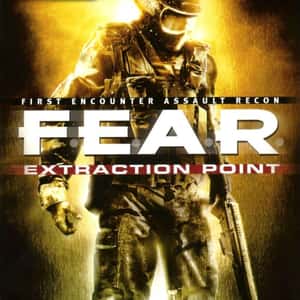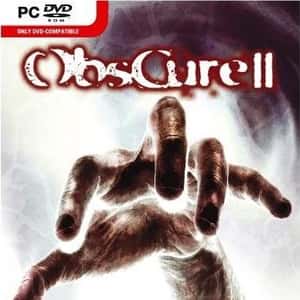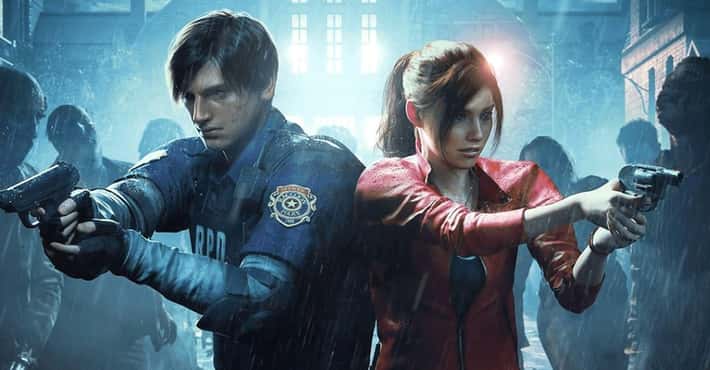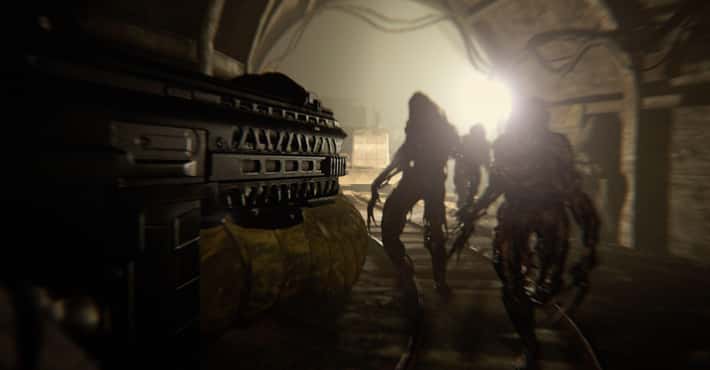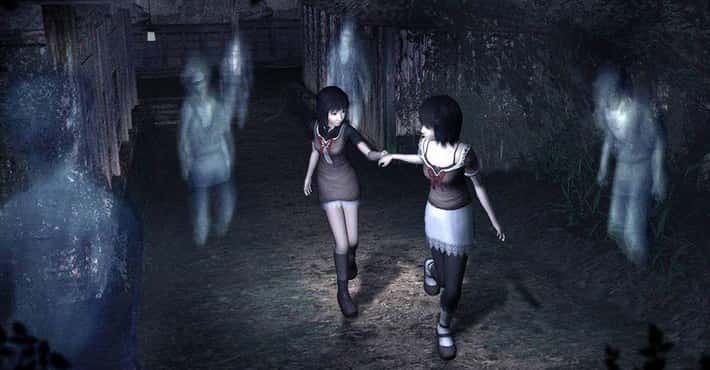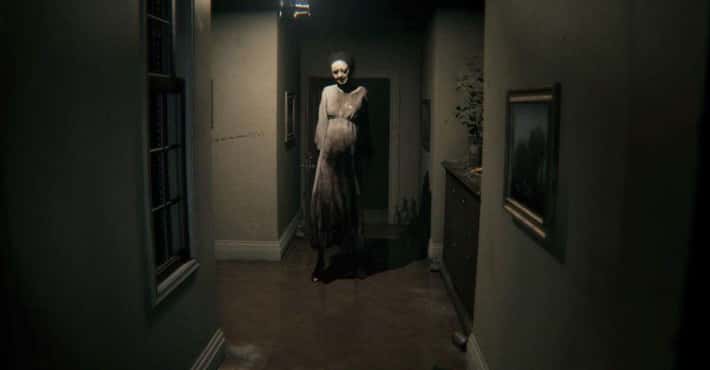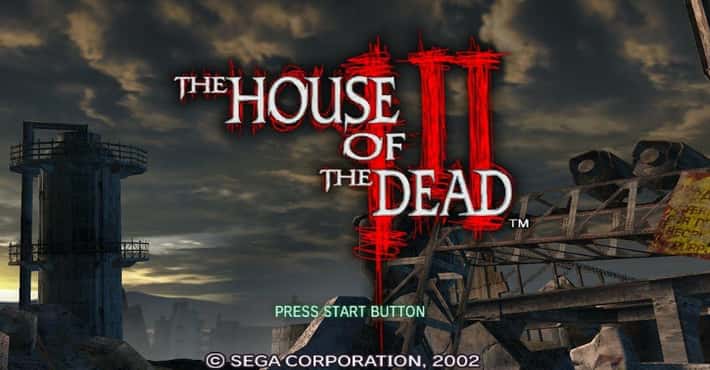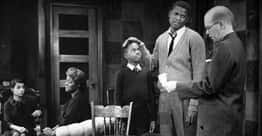- Jan 01 1994Ghoul Patrol is a Super Nintendo video game that is a sequel to Zombies Ate My Neighbors. It was released in September 1994 by LucasArts and later on the Wii Virtual Console in North America on January 25, 2010 and the PAL region on May 14, 2010. A Sega Mega Drive/Genesis version published by Virgin Interactive was also to be released, but it was cancelled before launch.
- Monster Madness: Battle for Suburbia is a video game for the Xbox 360 and Windows. Developers Artificial Studios and Immersion Games say that players are able to combine objects found around the town to create bigger and better weapons with which to destroy the monster menace. The game includes five environments and hundreds of enemies. Four-player cooperative play is available as well.
- Sep 07 2001From Dusk Till Dawn is a third-person shooter that is based on events that transpire directly after the end of From Dusk till Dawn. Released in 2001 for Windows, it was distributed by Cryo Interactive.
- Sep 09 2000The Ring: Terror's Realm is a survival horror video game developed and published by Asmik Ace Entertainment in Japan and published by Infogrames in North America. It was released for Dreamcast on February 24, 2000 in Japan and August 22, 2000 in North America. It is based on the Ring series of novels by Japanese author Koji Suzuki, which also inspired the Japanese film Ring and its American remake, The Ring.
- Apr 03 2005
Plunging players into the eerie, mysterious halls of Leafmore High, ObsCure offers a unique cooperative experience in the realm of survival horror. The game follows five students, each with their own abilities and skills, as they work together to uncover the dark secrets hidden within their school. Featuring a character-swapping mechanic reminiscent of Resident Evil Zero, ObsCure emphasizes teamwork and strategy in order to survive the onslaught of grotesque creatures lurking within the shadows. For fans seeking a cooperative experience that doesn't shy away from the tension and terror of classic horror gaming, ObsCure is an ideal choice.
- Jun 20 1997Blood is a first-person shooter video game developed by Monolith Productions and published by GT Interactive Software. The full version was released for the PC on May 31, 1997. The game follows the story of Caleb, an early 20th century gunslinger seeking revenge against the dark god Tchernobog. It features a number of occult and horror themes. Blood includes an arsenal of weapons ranging from the standard to the bizarre, numerous enemies, and liberal amounts of graphic violence. The Blood franchise was continued with two official expansion packs titled Plasma Pak and Cryptic Passage. Later, a sequel entitled Blood II: The Chosen was released on October 31, 1998. The game was released on Steam along with its two expansion packs on July 14, 2014, utilizing the DOSBox emulator to run on modern systems.More Blood
- #32 of 48 on'90s Video Games You Were Too Afraid to Play in the Dark
- #53 of 55 onWhat is the MOST Offensive Smell of All?
- #88 of 100 onThe Best First Person Shooter Games of All Time
- Jan 01 1993Zombies Ate My Neighbors is a run and gun video game developed by LucasArts and originally published by Konami for the Super Nintendo and Sega Genesis consoles in 1993. One or two players take control of protagonists Zeke and Julie in order to rescue the titular neighbors from monsters often seen in horror movies. Aiding them in this task are a variety of weapons and power-ups that can be used to battle the numerous enemies in each level. Various elements and aspects of horror movies are referenced in the game with some of its more violent content being censored in various territories such as Europe and Australia, where it is known only as Zombies. While not a great commercial success, the game was well received for its graphical style, humor and deep gameplay. It spawned a sequel, Ghoul Patrol, released in 1994. In 2009, Zombies Ate My Neighbors was re-released for the Virtual Console to positive reviews.
- #32 of 132 onThe Best-Rated Super Nintendo Games
- #83 of 165 onVideo Games That Should Be Movies
- #13 of 58 onThe 50+ Best Co-Op SNES Games, Ranked
- Jan 01 1993Gabriel Knight: Sins of the Fathers is a 1993 point-and-click adventure game written, designed and directed by Jane Jensen and published by Sierra On-Line. It is the first game of the Gabriel Knight series. Sins of the Fathers follows the eponymous Gabriel Knight, owner of a rare book store and fledgling writer, as he investigates a series of local murders he plans to use as the basis for his new novel. Its CD-ROM version includes voice-acting by Tim Curry, Mark Hamill, Michael Dorn, Efrem Zimbalist, Jr., and Leah Remini among others. A remake titled Gabriel Knight: Sins of the Fathers 20th Anniversary Edition, co-developed by Jane Jensen's Pinkerton Road and Phoenix Online Studios, was released for Windows, Mac, iPad, and Android on October 15, 2014.
- Jan 01 2002Galerians: Ash is a survival horror video game developed by Polygon Magic, published by Enterbrain and distributed by Sammy Studios for the Sony PlayStation 2. Galerians: Ash is the sequel to Galerians, a PlayStation game. It is a psychic action game with a dark setting. It follows the story of a young man named Rion who has psychic powers and the resiliency to overcome the Last Galerians, a genetically engineered group of superhumans whose purpose is to wipe out humankind.
- 2004Glass Rose is a point-and-click adventure psychological horror video game developed by Cing and Capcom's Production Studio 3 and published by Capcom for the PlayStation 2. It was released in Japan on November 6, 2003 and later in Europe on March 26, 2004.
- Jul 31 2008Zero: Tsukihami no Kamen, informally known as Fatal Frame IV in North America and Project Zero 4 in Europe, is a survival horror video game developed by Grasshopper Manufacture and published by Nintendo for the Wii video game console as the fourth installment in the Fatal Frame / Project Zero series.
- Oct 31 2007Dementium: The Ward is a survival horror first-person shooter game developed by Renegade Kid for the Nintendo DS. The game was originally released in North America on October 31, 2007, courtesy of Gamecock Media Group. In September 2014, Jools Watsham of Renegade Kid announces on his official Twitter account that the developer finally gained back the rights to the title, and have later announced plans to release an enhanced version of the game on the Nintendo 3DS eShop in Q2 2015.
- Jan 01 1995
Continuing the eerie narrative of its predecessor, Dark Seed II finds protagonist Mike Dawson once again trapped between the real world and a dark, twisted parallel universe. The game boasts an atmospheric, hand-drawn visual style inspired by the works of H.R. Giger, adding to the chilling and unsettling atmosphere that pervades the experience. With its point-and-click interface, challenging puzzles, and engrossing storyline, Dark Seed II offers a nostalgic journey into the realms of psychological horror and classic adventure gaming.
Developed and published by Cyberdreams in 1995, Dark Seed II is a sequel to the adventure game Dark Seed, and sees recurring protagonist Mike Dawson's continued adventures in the H.R. Giger artwork-based "Dark World." Designed and written by future James Bond novelist Raymond Benson, the game was released for Microsoft Windows 3.x, Sega Saturn, and Sony PlayStation. As was the case with Dark Seed, console versions of Dark Seed II were released only in Japan, though they were additionally fully dubbed in Japanese. Unlike the original game, the Saturn version of Dark Seed II does not support the Saturn mouse. - Jul 09 2003
Set on a desolate Martian research facility, Martian Gothic: Unification thrusts players into a tense, suspenseful mystery as they take control of three separate characters, each with their own abilities and stories. As players unravel the terrifying secrets behind the facility and its mutated inhabitants, they must piece together clues, solve puzzles, and navigate a hostile environment to survive. With its atmospheric settings, intricate narrative, and unique gameplay mechanics, Martian Gothic: Unification stands as an underrated gem within the realms of survival horror and sci-fi gaming.
Martian Gothic: Unification is a survival horror video game developed by Creative Reality for Microsoft Windows and Coyote Developments for the PlayStation and published by TalonSoft for Microsoft Windows and Take-Two Interactive for the PlayStation. The PlayStation version was one of a number of "budget titles" released near the end of the system's lifespan. - Nov 30 1996Phantasmagoria: A Puzzle of Flesh is also known as Phantasmagoria 2 and released as Phantasmagoria II: Fatal Obsessions in European countries. It is an interactive movie survival horror point-and-click adventure game released in 1996 by Sierra Entertainment. Though technically a sequel to Roberta Williams' 1995 game Phantasmagoria, Puzzle of Flesh shares no connections with its predecessor in plot nor characters, as Sierra initially intended the Phantasmagoria title to be a horror anthology, with each installment of a different story and style. While not a commercial success, A Puzzle of Flesh, like its predecessor Phantasmagoria, is remembered for its controversial violent and sexual content, which led the game to being heavily censored or banned outright in several European and Oceanic countries.
- Jun 11 1998Hellnight, known as in Japan, is a first-person survival horror video game developed and published by Atlus Co. in collaboration with Konami in 1998. The game's popularity was low, possibly because it wasn't released outside of Japan and Europe, and received little media attention. However, the game did get a small cult following due to the increasing popularity of horror games in recent years.
- Jan 01 1983
- Alone in the Dark is the fifth installment of the survival horror video game series under the same name created by Atari. The game was released for Microsoft Windows, Xbox 360 and Wii in Europe, North America, and Australia in June 2008. The PlayStation 3 version, titled Alone in the Dark: Inferno, was released on November 18, 2008 and includes several enhancements from the other versions. The Windows, Xbox 360 and PlayStation 3 were released by Electronic Arts in Japan in December 2008. The Windows, Xbox 360 and PlayStation 3 versions were developed by Eden Games while the PS2 and Wii versions were simultaneously developed by Hydravision Entertainment. The PS2/Wii version of Alone in the Dark is a completely different game from the PS3/X360 version. Though both have a similar plot, it has largely different levels, removing all the freeroaming from the other versions. Despite receiving mixed to negative reviews, Alone in the Dark was a financial success.
- Jan 01 1995Gakkou de atta Kowai Hanashi is a Survival Horror text-based visual novel for the Super Famicom that was released in 1995 by Banpresto. The game features photographs of real Japanese actors/models, and CAMERA J.
- Jan 01 1987Laplace no Ma is a Japanese video game released in 1987 for the NEC PC-8801 and NEC PC-9801. The game was also ported to Sharp X68000, the SNES and TurboGrafx-CD.
- Jan 01 2000Carrier is a survival horror video game for the Dreamcast, notable in part for being fully 3D - then still a rarity for survival horror games, which mostly displayed 3D characters over pre-rendered backgrounds. In Carrier, players assume the separate roles of an investigation team that was split up from a surprise attack. A cancelled sequel for the PlayStation 2 titled Carrier: The Next Mutation was once planned for release.
- Jan 01 1984
- Sep 16 2003Dino Crisis 3 is a 2003 action-adventure video game for the Xbox. It was developed by Capcom Production Studio 4, and is the fourth and final video game in the Dino Crisis series. Like the previous iterations of the series, gameplay revolves around fighting dinosaur or other reptiles. The action takes place in outer space, on a space station. Unlike the earlier installments of the Dino Crisis trilogy, the enemies in the game are not real dinosaurs. They are mutations created from DNA extracted from various dinosaur species. The game was originally planned for both Xbox and PlayStation 2, but the latter version was scrapped early in development.
- Jan 01 1997Nightmare Creatures is a survival horror video game released for the PlayStation, Microsoft Windows and Nintendo 64. It was developed by Kalisto Entertainment and published by Activision and Sony Computer Entertainment. A sequel was released 3 years later entitled Nightmare Creatures II.
- Aug 31 1999Blue Stinger is an action survival horror game released in 1999 for the Dreamcast game console. It was localized in North America, Europe and Australia by Activision. This game was originally developed by a Japanese video game studio, Climax Graphics, and designed by then Climax CEO, Shinya Nishigaki.
- F.E.A.R. Extraction Point is an expansion pack for the psychological horror first-person shooter video game F.E.A.R., published by Vivendi Universal and developed by TimeGate Studios. It was released on October 24, 2006 for Microsoft Windows and requires the full original game in order to be played. Also, a stand-alone single player demo has been previously released. The expansion was ported to the Xbox 360 and released as part of the F.E.A.R. Files package on November 6, 2007. This expansion owes its name to the game's ultimate goal for the player, to reach the extraction point and leave the city where the adventure takes place. Extraction Point adds new weapons, enemies, and single-player levels, but no new multiplayer content. Additional improvements were also made to the enemy artificial intelligence. The sequel to F.E.A.R., F.E.A.R. 2: Project Origin, ignores the events of both expansion packs.
- Jan 27 2000Resident Evil Survivor, known in Japan as Biohazard Gun Survivor, is a first person shooter video game developed by TOSE and published by Capcom. It was released on the PlayStation in Japan on January 27, 2000, in Europe on March 31, 2000 and in North America on August 30, 2000. It is a spin-off to the Resident Evil video game series. As the first release of the Gun Survivor series, this game was a major difference from the main Resident Evil series, substituting the third-person perspective of the previous games to the first-person view. The Japanese and European versions of the game were compatible with Namco's GunCon/G-Con 45 light gun, making it one of the first off-rail light gun games, whereas light-gun compatibility was removed from the North American release due to shooting games being partly blamed for the motivation of the then-recent Columbine High School massacre.
- 2004ObsCure II is a survival horror video game developed by Hydravision Entertainment and published by Playlogic in PAL regions and Ignition in North America for Microsoft Windows, PlayStation 2 and Wii. It is the sequel to the 2004 video game ObsCure. The game was released on September 7, 2007 in Europe, March 25, 2008 under the name ObsCure: The Aftermath in North America and June 12, 2008 in Australia. Later in 2009, Playlogic announced a PlayStation Portable version and was released on September 29, 2009. It was later released on Steam in 2014.
Filed under:
Fact-checked by:MichaelChoi
20 MORE LISTS
Seriously Scary Video Games
Grab your flashlight, dim the lights, and twiddle your thumbs in terror as we rank the scariest video games and series in history. Wait...did you hear that?






